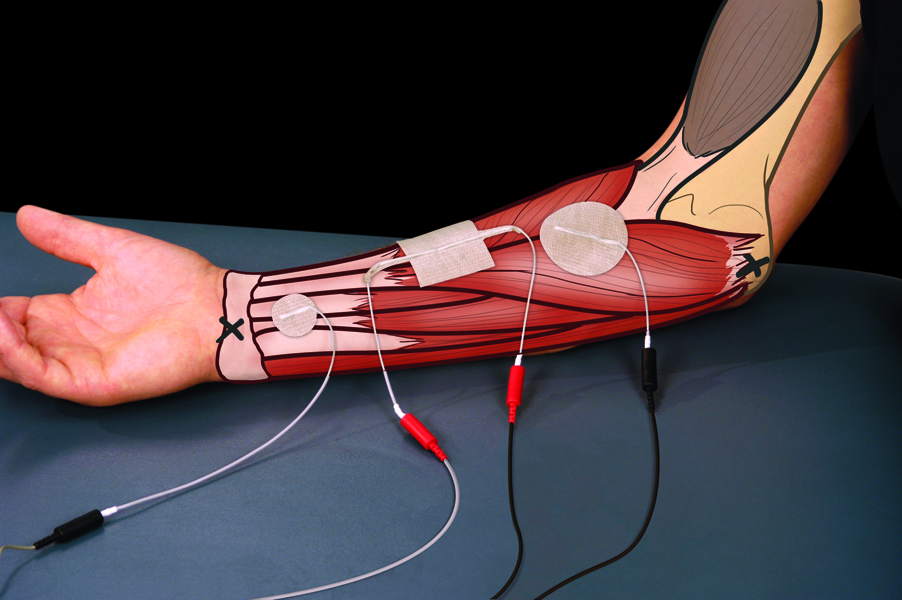Power Grasp: Dual Channel
Electrode Placement

Application Instruction by Dr. Lucinda Baker
Electrode placement for power grasp, using dual channel stimulation. The medial condyle and the pisiform bone are marked with X's. The negative electrode of channel one is placed over the ulnar nerve just proximal to the pisiform bone. The positive electrode is connected with a dual leadwire electrode at the mid forearm. The negative electrode of channel two is placed over the extrinsic finger flexors. The positive electrode for channel two is also connected to the dual leadwire electrode at the mid forearm.
Related Electrode Placements
Power Grasp: Dual Channel
Video Instruction
Audio Transcript:
Electrode placement for power grasp, using dual channel stimulation. The medial condyle and the pisiform bone are marked with X's. The negative electrode of channel one is placed over the ulnar nerve just proximal to the pisiform bone. The positive electrode is connected with a dual leadwire electrode at the mid forearm. The negative electrode of channel two is placed over the extrinsic finger flexors. The positive electrode for channel two is also connected to the dual leadwire electrode at the mid forearm.
The stimulation of channel one results in metacarpal phalangeal flexion. Stimulation of channel two results in distal and proximal interphalangeal flexion. When the two channels are combined a power grasp occurs. This would be graded as a three plus out of five muscle contraction.
Power Grasp: Dual Channel
Muscle Anatomy

Muscles involved in power grasp: (extrinsic)
Flexor Digitorum Superficialis
Origin: Medial epicondyle of the
humerus (common flexor tendon) as
well as parts of the radius and ulna
Insertion: Anterior margins on the
base of the middle phalanges of the
four fingers
Flexor Digitorum Profundus
Origin: Upper 3/4 of the anterior and
medial surfaces of the body of the
ulna, interosseous membrane and
deep fascia of the forearm
Insertion: Base of the distal phalanges
of the fingers
Flexor Pollicis Longus
Origin: The middle 1/2 of the anterior
surface of the radius and the adjacent
interosseus membrane
Insertion: The base of the distal phalanx
of the thumb
Note: It is not uncommon for the flexor digitorum superficialis to be absent from the 5th digit making it difficult to identify 5th digit injury.
Muscles involved in power grasp: (intrinsic)
Interosseous Muscles (Palmar)
Origin: Each interossei originates from a
medial or lateral surface of a metacarpal
Insertion: into the extensor hood and
proximal phalanx of same finger
Lumbrical Muscles
Origin: Tendon of the flexor digitorum
profundus
Insertion: They pass dorsally and laterally
around each finger, and inserts into the
extensor hood
Power Grasp: Dual Channel
Nerve Anatomy

Nerves involved in power grasp: (extrinsic)
Flexor Digitorum Superficialis
Nerve: Median nerve
Nerve root: C8, T1
Flexor Digitorum Profundus
Nerve innervation: The medial half (acts on
digits
IV & V) is innervated by the ulnar nerve. The
lateral half (acts on digits II & III) is innervated
by the anterior interosseous branch
of the median nerve
Nerve root: C8, T1
Flexor Polliicis Longus
Nerve innervation: Median nerve (anterior
interosseous branch)
Nerve root: C8, T1
Nerves involved in power grasp: (intrinsic)
Interosseous Muscles (palmar)
Nerve innervation: ulnar nerve
Nerve root: C8-T1
Lumbrical Muscles
Nerve innervation: The lateral two
lumbricals (of the index and middle
fingers) are innervated by the
median nerve. The medial two
lumbricals (of the little and ring
fingers) are innervated by the ulnar
nerve
Nerve root: C8-T1
This website uses cookies to analyze site traffic and provide you with the best experience possible. Learn more
This website uses cookies to analyze site traffic and provide you with the best experience possible.
Learn more
